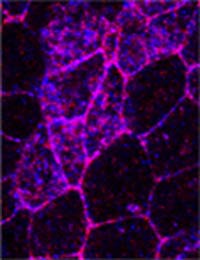How are cells held together?

When cellular adhesives come unstuck… One of the components of the exocyst has been inactivated in these cells. The two cellular adhesives – cadherin (pink) and _-catenin (blue) – are dispersed through the cytoplasm instead of being localized essentially at the membranes, to form the intercellular junction. © J. Langevin/Institut Curie
At the Institut Curie, the CNRS team of Yohanns Bellaïche has just discovered a new cellular component that participates in the organization of cells in the epithelium. This tissue, which forms a barrier between our body and the outside world, is an extremely coherent structure of myriad cells that fit together according to very precise rules. This cohesion holds together the tissues that compose the organs and controls the “comings and goings” of various substances between the outside world and our body.
The Institut Curie CNRS researchers’ discovery sheds light on how cells “stick together”, thereby ensuring the cohesion needed for proper bodily functioning, but also clarifies the problems that may arise if this cellular cohesion is impaired. When tumor cells no longer stick together, they can move around and invade other tissues. This leads to a risk of propagation via metastases, which complicates the treatment of cancer.
These results are published in the September 2005 issue of Developmental Cell.
The epithelium lines all the cavities of our body. Like a border, it separates inside from out: the skin isolates us from the outside world, epithelial cells lining the small intestine separate the intestinal cavity – the “lumen” – from the rest of the body. The epithelium also regulates “toing and froing” across the border, since its cells are polar – they have a sort of compass which tells them which way is out and which in:
– This polarity controls the point of adhesion between cells, which are held together by adhesion proteins. If cellular cohesion is impaired, epithelial integrity is altered and in certain cases this can have unfortunate consequences (see “When cells go walkabout”).
– Epithelial cells are directional. They have a so-called brush border – the apical surface(1) – which optimizes surface exchange with the outside.
The epithelium, the body’s “border guard”
Cell polarity regulates the flow of information between inside and out, controls the passage of various substances (water, ions, nutrients…) between body compartments, and filters the molecules to be transported, into the blood vessels, for example.
The polarity of epithelial cells is in part maintained by a highly organized transport network which ensures that molecules are correctly directed to their “place of work” where they can perform their specific tasks. Polarity is also involved in the distribution of membrane receptors that regulate cell growth. Loss of polarity due to failure of one of the cellular adhesives – a-catenin – leads to the appearance of tumor cells whose growth is perturbed(2).
Trafficking of cellular adhesives
At the Institut Curie, Yohanns Bellaïche’s CNRS team(3) has just shown that one of the transporters of certain molecules to the cell membrane, the exocyst complex(4), plays a key role in the transport of one of the cellular adhesives, cadherin, to the junction with the adjacent cell. There, cadherin joins two other proteins(5) equally vital for cellular cohesion. Together, these adhesion proteins hold the cells together.
CNRS scientists at the Institut Curie have for the first time found evidence that the exocyst plays a part in maintaining the polarity of epithelial cells, which are essential for proper bodily functioning.
This discovery also casts light on the risks associated with loss of this function. When tumor cells lose their capacity to adhere to neighboring cells, they are able to move around and invade other tissues, leading to a risk of metastases. Clear understanding of the mechanisms of cellular adherence could enable the formation of metastases to be limited by maintaining the cohesion of tumor cells.
Media Contact
All latest news from the category: Life Sciences and Chemistry
Articles and reports from the Life Sciences and chemistry area deal with applied and basic research into modern biology, chemistry and human medicine.
Valuable information can be found on a range of life sciences fields including bacteriology, biochemistry, bionics, bioinformatics, biophysics, biotechnology, genetics, geobotany, human biology, marine biology, microbiology, molecular biology, cellular biology, zoology, bioinorganic chemistry, microchemistry and environmental chemistry.
Newest articles

Superradiant atoms could push the boundaries of how precisely time can be measured
Superradiant atoms can help us measure time more precisely than ever. In a new study, researchers from the University of Copenhagen present a new method for measuring the time interval,…

Ion thermoelectric conversion devices for near room temperature
The electrode sheet of the thermoelectric device consists of ionic hydrogel, which is sandwiched between the electrodes to form, and the Prussian blue on the electrode undergoes a redox reaction…

Zap Energy achieves 37-million-degree temperatures in a compact device
New publication reports record electron temperatures for a small-scale, sheared-flow-stabilized Z-pinch fusion device. In the nine decades since humans first produced fusion reactions, only a few fusion technologies have demonstrated…





















